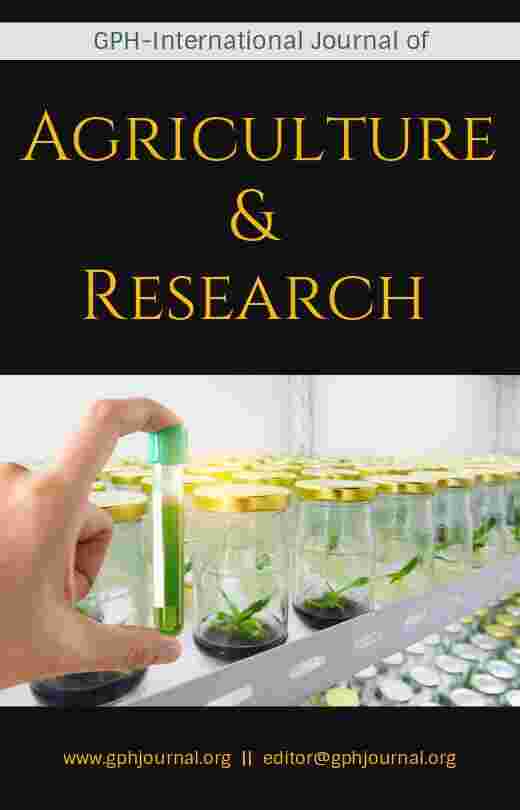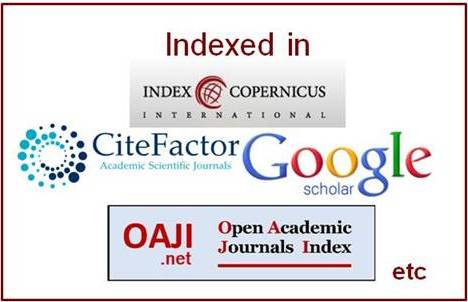THE RESPONSE OF COCOYAM (Colocasia esculentus (L). Schott) TO MIXTURE OF ORGANIC AND INORGANIC FERTILIZERS IN MUBI, ADAMAWA STATE NIGERIA
Abstract
A field experiment was conducted at the Adamawa State University, Faculty of Agriculture Department of Crop Science Teaching and Research farm during the 2019 rainy season. To evaluate response of cocoyam (Colocasia esculentus(L). Schott) to mixture of organic and inorganic fertilizers, with the objective of selecting the best fertilizer mixture that can enhance the growth and yield of cocoyam. The experiments consisted of the following treatments T1 = 504 kg ha-1 cow dung, T2 = 227.65 kg ha-1 poultry droppings, T3 = 210.15 kg ha-1 NPK, T4 = 251.33 kg ha-1 cow dung +138.83 kg ha-1 poultry droppings, T5 = 215. 33 kg ha-1 cow dung + 105.08 kg ha-1 NPK, T6 = 138.83 kg ha-1 poultry droppings + 105.08 kg ha-1 NPK, T7 = 167.55 kg ha-1 cow dung + 92.55 kg ha-1 poultry droppings + 70.05 kg ha-1 NPK and T8 = Control. The experiment was laid out in a Randomized Complete Block Designed (RCBD) in three replicates. The result showed that T4 recorded the highest number of leaves and tillers at four weeks after fertilizer application, while the T1 recorded the highest number of leaves and tillers at ten weeks after fertilizer application. The yield characters also vary significantly across the treatments, with T7 yielded the highest number of corm per plot (74), 100 corm weight (6.40 kg), corm yield per plot (1.77 kg) and corm yield in kg ha-1(4425 kg ha-1). Significant positive correlation between corm yield in kg ha-1 with corm yield per plot (r = 0.9395**), 100 corm weight (r= 0.9555**) and number of corm per plot (r = 0.9453**). Suggest that improvement in these characters will enhance the yield of cocoyam. From the results of this research therefore, T7 the blend of 167.55 kg ha-1 Cow dung + 92.55 kg ha-1 Poultry droppings + 70.05 kg ha-1 NPK performed better, for yield character, and hence recommends as the best fertilizer mixture that can enhance the growth and yield of cocoyam in Mubi and environ.
Downloads
References
2. Ademiluyi, B. O. (2013). Evaluation of weed management strategies in cocoyam (Colocosia esculentus L.) production in Ado-Ekiti, Nigeria. International Journal of Agriculture and Soil Sciences, 3(2), 38 – 42.
3. Adesoji, S. A. and Farinde, A. J. (2006). Socio-economic factors influencing yield of arable crop in Osun State, Nigeria. Asian Journal of Plant Sciences, 5:630-634.
4. Anjana, D, and Kumar, J. P. (2013). Effect of integrated manuring on the growth and yield of (Centella asiatica L.). Tropical Ecology, 54(1): 89 - 95.
5. Anikwe, M. A. N., Mbah, C. A., Ezeaku, P. I. and Onyia, V. N. (2007). Tillage and plastic mulch effects on soil properties and growth and yield of cocoyam (Colocasia esculenta) on an Ultisol in southeastern Nigeria. Soil Tillage Research 93: 264–272.
6. Ano, A. O. and Agwu, J. A. (2005). Effect of animal manure on selected soil chemical properties (I). Nigerian Journal Soil Science, 15:14–19.
7. Ashraf, A. A. E. and Mahmoud, G. O. (2013). Modeling the influence of nitrogen rate and plant population density on seed yield, yield components and seed quality of safflower. American Journal of Experimental Agriculture, 3(2): 336 -360.
8. Ayoola O. T. and Adeniyan O. N. (2000). African J. Biotech., 5:1386-1392.
9. Ayoola, O. T. and Makinde, E. A. (2009). Maize growth, yield and soil nutrient changes with N-enriched organic fertilizers. African Journal of Food Agriculture and Nutritional Development, 9(1):580-592.
10. De la Pena, R. S. nd Plucknet, D. L. (1972). Effect of N fertilization on growth, composition and yield of upland and lowland taro (Colocasia esculenta). Exp. Agric., 8:187-194.
11. Druilhe, Z. & Barreiro-Hurle, J. (2012). Fertilizer subsidies in sub-Saharan Africa. Europe and South America Working paper No. 12-04. Rome, FAO.
12. Ekwe, K. C., Nwosu, K. I., Ekwe, C. C., & Nwachukwu, I. (2009). Examining the underexploited values of cocoyam (Colocasia and Xanthosoma spp.) for enhanced household food security, nutrition and economy in Nigeria. In H Jaenicka, J. Ganry, I. Zeledon Hoeschle & R Kahara (Eds.), Proceedings of the international symposium on underutilized plants for food security, income and sustainable development. Acta Horticulture, 86, 71–78.
13. Eneji A. E., Honna T., Yamamoto S. and Masuda T. (2003) Journal of Plant Nutrition, 26(8): 1595-1604.
14. FAO, (2013). B Adaptation to climate change in agriculture, forestry, and fisheries perspective flam work of Africa TKP. press.
15. Gebre, A., Bizuayehu, T. and Kassahun, B. M. (2015). Effect of Corm Size and Plant Population Density on Corm Yield of Taro (Colocasia Esculenta L.). International Journal of Advanced Biological and Biomedical Research, 3(3), 309-315.
16. Harrison, K. D., Judith, G. A. K. and Eliezer, B. B. (2014). Influence of poultry manure and NPK fertilization on growth, yield and storability of onion (Allium cepa L.) grown under rain fed conditions. American Journal of Experimental Agriculture, 4(8): 860 – 878.
17. Hota, R., Jena, A. K. and Narayana, K. L. (2014). Effects of inorganic and organic amendments on yield of cocoyam (Colocasia esculenta) and on soil properties. World Journal Agricultural Resources, 2(2):70-81.
18. IFA (1992). World fertilizer Use Manual. Publication of International Fertilizer Industry Association, Paris pp 148-160.
19. IFPRI. (2011) A Review of Literature on Agricultural Productivity, Social Capital and Food Security in Nigeria. International Food Policy Research Institute (IFPRI), NSSP Working Paper 21.
20. Ikpe, F. N. and Powel, J. M. (2003). Nutrient cycling practices and changes in soil properties in the crop livestock farming system of west Niger Republic of West Africa. Nutritional Cycle Agroecology, 62:37–45.
21. Kay D. E. (1972). Tropical Development and Research Institute, 380pp.
22. Lebot, V. (2009). Tropical root and tuber crops: Cassava, sweet potato, yams and aroids. UK: CABI Publishing.
23. Lema, K. M., Tata-Hangy, K. and Bidiaka, M. (2004). Management of African root and tuber scale using improved cassava genotypes and mineral fertilizers Afr. Crop Science Journal, 12(24): 217-221.
24. Lim, T. K. (2016). Edible medicinal and non-medicinal plants, 1st edn. New York, London: Springer.
25. Mare, R. and Modi, A. T. (2009). Influence of planting date and organic fertilization on growth and yield of Taro landraces. African Crop Sci. Conf. Proc., 9:179-189.
26. Mera, U. M., Singh, B. R., Magaji, M. D., Singh, A., Musa, M. and Kilgori, M. J. S. (2009). Response of Roselle to farm yard manure and nitrogen fertilizer in the semi arid zone of Nigeria. Nigerian Journal of Basic and Applied Science, 17(2): 246-251.
27. Obigbesan, G. O. (1980). Nutrient requirements of yams. Agriculture Research Bulletin, University of Ibadan, Nigeria 12(1):1–20.
28. Ogbonna, P. E. and Nwaeze, N. J. (2012). Evaluation of growth and responses of cocoyam (Colocasia esculenta) cultivars to rates of NPK 15:15:15 fertilizer. African Journal of Agricultural Resources, 7(49):6553-6561.
29. Ohiri A. C., Ogbonnaya J. C., Enyinnaya A. M., Ojinaka, T. L., Chukwu G. O. (1988). Annual Report, NRCRI, Umudike, pp75-77.
30. Ohiri, A. C. (1996). Soil physical and chemical conditions favourable for yam (Dioscorea sp.) growth and tuber development in Nigeria. African Soil, 28:231–242.
31. Ojeniyi, S. O., Amusan, O. A. and Adekiya, A. O. (2013). Effect of poultry manure on soil physical properties, nutrient uptake and yield of cocoyam (Xanthosoma sagittifolium) in South west Nigeria. American-Eurasian Journal of Agriculture Environmental Science, 13(1):121-125.
32. Okoroafor, I. B., Okelola, E. O., Edeh, O., Nemehute, V. C., Onu, A., Nwaneri, T. C. and Chinaka, G. (2013). Effect of organic manure on the growth and yield performance of maize (Zea mays l.) in Ishiagu. Journal of Agriculture and Veterinary Science, 5(4): 28 -31.
33. Onwueme I. C. and Sinha T. O. (1991). Field crop production in Tropical Africa, CTA Ede, The Netherlands, pp 276-288.
34. Plucknet, A. E., (1972). Effect of organic extracts on the growth and flowering of marigold plants (Calendula officinalis L.). Journal of Organics, 1(1): 22-30.
35. Purseglove, J. W. (1975). Tropical Crop Monocotyledonous. Longman Group Ltd., Britain.
36. Pypers, P., Bimponda, W., Lodi-Lama, J. P., Lele, B., Mulumba, R., Kachaka, C., Boeckx, P., Merckx, R. and Vanlauwe, B. (2012). Combining mineral fertilizer and green manure for increased: profitable cassava production. Agronomy Journal, 104 (12): 178-187.
37. Roberts, T. L. (2007). Right product, right time, right rate and right place…the foundation of best fertilizer management practices. Proceedings of the IFA International Workshop on Fertilizer Best Management Practices: General Principles, Strategy for Their Adoption and Voluntary Initiatives Vs Regulations, March 7-9, 2007, Brussels, Belgium, pp: 29-32.
38. Shiyam J. O. and Binang, W. B. (2013) Effect of poultry manure and plant population on productivity of fluted pumpkin (Telfaiaria occidentalis hook f.) in Calabar, Nigeria. Journal of Organic Systems, 8(2): 29-35.
39. Som, D. (2007). Handbook of Horticulture, Indian Council of Agricultural Research, New Delhi, pp 507-508.
40. Steiner K. G. (1991). In: Mokwunye A. U. (ed.) Alleviating soil fertility constraints to increased crop production in West Africa pp69-91.
41. Udoh, D. J., Ndon. B. A., Asuquo, P. E. and Ndaeyo, N. U. (2005). Crop Production Techniques for the Tropics. Concept Publications, Nigeria. p. 464.
42. Uwa, D. F., Udoh, A. U. and Iwo, G. A. (2011). Effect of organic and mineral fertilizers on the growth and yield of cocoyam (Colocasia esculenta (L.) Schott). International Journal of Agricultural Science, 3(1):1-6.

Copyright (c) 2021 GPH - IJAR International Journal of Agriculture and Research

This work is licensed under a Creative Commons Attribution-NonCommercial-NoDerivatives 4.0 International License.
Author(s) and co-author(s) jointly and severally represent and warrant that the Article is original with the author(s) and does not infringe any copyright or violate any other right of any third parties, and that the Article has not been published elsewhere. Author(s) agree to the terms that the GPH Journal will have the full right to remove the published article on any misconduct found in the published article.
























